#Model Evaluation
Explore tagged Tumblr posts
Text
What is Data Science? A Comprehensive Guide for Beginners

In today’s data-driven world, the term “Data Science” has become a buzzword across industries. Whether it’s in technology, healthcare, finance, or retail, data science is transforming how businesses operate, make decisions, and understand their customers. But what exactly is data science? And why is it so crucial in the modern world? This comprehensive guide is designed to help beginners understand the fundamentals of data science, its processes, tools, and its significance in various fields.
#Data Science#Data Collection#Data Cleaning#Data Exploration#Data Visualization#Data Modeling#Model Evaluation#Deployment#Monitoring#Data Science Tools#Data Science Technologies#Python#R#SQL#PyTorch#TensorFlow#Tableau#Power BI#Hadoop#Spark#Business#Healthcare#Finance#Marketing
0 notes
Text
0 notes
Text
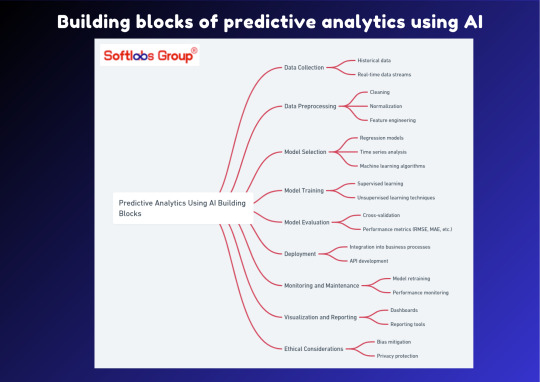
Explore the building blocks of predictive analytics using AI with our informative guide. This simplified overview breaks down the essential components that enable accurate forecasting and decision-making, empowering businesses to anticipate trends and make informed decisions. Perfect for those interested in leveraging AI for predictive insights. Stay informed with Softlabs Group for more insightful content on cutting-edge advancements in AI.
0 notes
Text
Grading in the AI era is like *looks at first submission* huh that's a weird mistake *sees the same mistake in 4 other submissions* oh this is the chatGPT answer to this question isn't it
#they have to evaluate a website using an acronym checklist#which - don't get me started. web eval checklists are trash#but it was built into the program's assessment cycle#so I left it in and just also teach better web evaluation strategies#the point is each letter stands for a specific thing#but a whole bunch of students have confidently completed the acronym checklist as if the letters stand for entirely different things?#and all did it the same way#so apparently that's what the latest AI model is spitting out
94 notes
·
View notes
Text
the more i use the used chair, the more i realize that i kinda um. want to radically change the chair im getting through insurance. it's too late to change now, and it would be a little embarrassing bc (a) the used chair i took the footrests off (and it's a folding, so i can do that without stress on the frame) and i find that i absolutely love having no footplate !! i love being able to easily kick myself around !! i just lift my feet off the ground when im moving and super easy brake: put my feet down!! instead of tearing up my hands trying to stop the push rims.
(b) before i got the used chair, my atp at the eval pushed me towards a folding chair. i went back a day later after reading a fuckton of reddit threads and went "oh no, actually give me a rigid chair. yes it's fine that itll stop me from foot propelling. id rather have a lighter chair than be able to foot propel 😇. im 1000% sure on this and i absolutely will not change my mind." and i would feel so embarrassed about going back with my tail between my legs and saying "ok after using a chair for awhile, i really wanna change um everything about the chair insurance is buying me 😅." and i cant just remove the footplate off a rigid chair bc the frame depends on the footplate being there, it needs that support. but also i now know ... i wanna foot propel !! i want my feetsies on the ground !!!
#borbtalks#technically i could just cancel the order. say i wanna wait a bit. wait until my physical in jan & ask my dr to give me another referral#and go through the entire evaluation process once more. except it would have to be ya know. at the place an hour away 😭#and then see about asking the rep if we can schedule to demo some chairs#bc at my last eval she brought no chairs !!! i was flying entirely blind !!!!!#and technically like. i could just ask her to change the model again. but idk even what to.
3 notes
·
View notes
Text
A good while ago, I watched this video about an MtG interaction between Ashaya and Blood Moon, and aside from my usual gripes with Blood Moon's wording, there was something that really bothered me: The comments. Specifically, people failing to understand the beautiful way that the rules handle continuous effects (specifically, continuous effects generated by static abilities). So let's go on a quick* trip through the magical world of card game rules.
And no, it's not about layers.
Continuous effects are when a card is continuously affect the game state; for example, increasing the power of all elves by 1. However, continuous effects also use information about the current game state to determine what exactly they do; for example, the effect above needs to know what creatures on the field are elves. This can cause problems when multiple continuous effects start messing with each other.
Take this card for example:

"The monster(s) with the highest ATK on the field is unaffected by the effects of Spell Cards." That's a perfectly reasonable effect, very intuitive, easy to apply. For example, if the two monsters on the field are these:


Then Blue-Eyes will be unaffected by spells. So if someone plays Dark Hole:
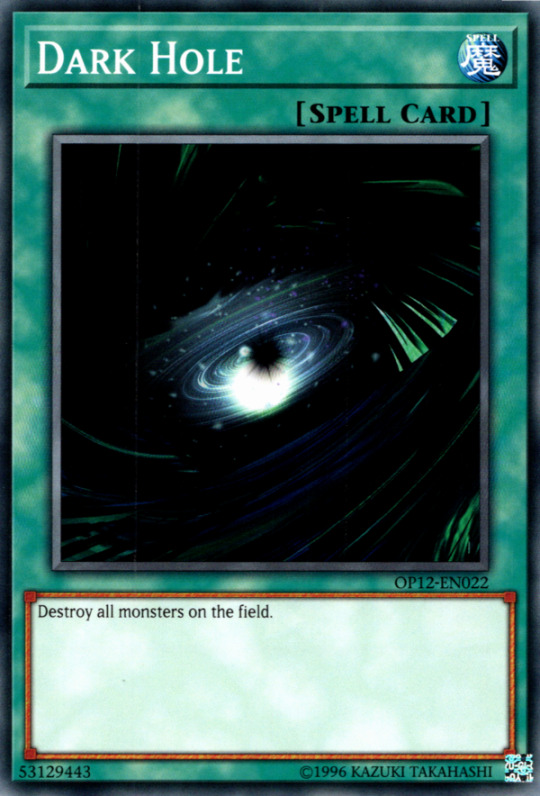
Then Dark Magician will be destroyed, but Blue-Eyes will not. Simple. Now, another very simple question, what happens if someone equips Dark Magician with this:

It gains 700 ATK, which means it has 3200 ATK. Which means it's the highest ATK on the field. Which means that, because of Pole Position, it's unaffected by spell cards. Which means it's no longer affected by Magic Formula. Which means its ATK is 2500 again and thus Blue-Eyes has the highest ATK. Which means it's affected by Magic Formula and gains 700 ATK. Which means it's the highest ATK...
The Yugioh rules address situations like these by saying "Please don't do anything that would start a loop."
And looking at Ashaya + Blood Moon, you might think the same thing would happen:

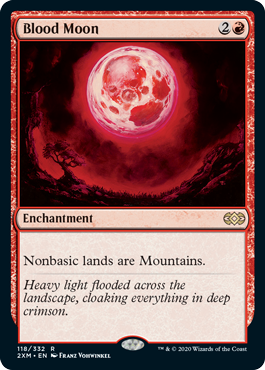
For clarity, Blood Moon's effect also causes nonbasic lands to lose all their abilities. They didn't write this on the card because they hate you.
So what you might expect to happen is that Ashaya turns itself into a land. Because it's now a land (and not basic), Blood Moon makes it a Mountain and takes away its abilities. But since Ashaya's ability that made it a land is gone, that means it isn't a land anymore. That means that Blood Moon stops applying to it. That means it gets its abilities back. That means it turns itself into a land. So now it's affected by Blood Moon...
But we've all watched the video, so we know that what actually happens is that Ashaya ends up as a land creature with no abilities (except the Mountain ability of T: Add {R}). But what happens when Ashaya's controller (let's call her Amy) plays another creature after Ashaya has lost its abilities? (and let's say there's a +1/+1 counter keeping Ashaya alive)
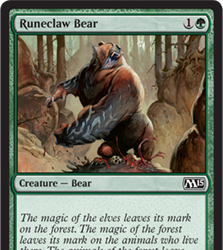
Well, obviously, nothing will happen; Ashaya no longer has its ability that turns Amy's creatures into lands, so the bear stays a regular creature. And THIS, THIS is the failure to understand layers that INFURIATES me, because obviously, OBVIOUSLY the bear becomes a Land Creature - Mountain Bear!
Unfortunately, if you don't immediately get an intuitive understanding of the beautiful design of the way MtG handles continuous effects, it's actually super unintuitive and hard to explain. Which is why I've come up with a model to help understand why Ashaya's ability is NOT gone, and in fact still applies to the bear even though Blood Moon already made Ashaya lose its abilities.
The way we players are used to understanding the game is through what I'll call the Final Game State, where all the continuous effects have applied to the cards on the field. 99% of the time, the final game state is what matters. In the final game state, Ashaya has no abilities besides T: Add {R}, so it seems like it can't possibly turn the bear into a land. But this way of viewing the game is flawed: If Ashaya truly doesn't have its ability, then it shouldn't be a land. But if it isn't a land, then Blood Moon doesn't apply... How do we avoid the loop?
Let's go back to the fundamental problem of continuous effects: They affect the game state, but they also use information from the game state. When two continuous effects are each altering the information that the other uses, we get a loop. The solution: Don't make continuous effects get their information from the final game state.
DISCLAIMER: I just read through the comprehensive rules sections 611 and 613 and while 613.1 matches my understanding for individual objects, there's nothing about how the game state as a whole is determined, and little about determining the existence or nonexistence of continuous effects. However, I'm pretty sure I'm right, so I'm probably right. Anyway,
The core idea of the model is this: There are multiple game states in existence at any given moment. The first is the raw game state, which is dependent purely on the cards on the field, unmodified by continuous effects. All other game states, including the final game state, are dependent on the raw game state (though not always directly dependent)
Let's say we have just an Ashaya on the field, nothing else. To find the final game state, we start from the raw game state: Ashaya is a 0/0 legendary creature - avatar, with its 2 printed abilities. From here, we find all the continuous effects that exist that haven't been applied yet. There are 2, generated by Ashaya's abilities: One that turns it into a Forest, and another that sets its power/toughness. We apply the Forest one first because of layers (not important).
Normally, we think of "applying a continuous effect" as modifying the game state. But in this model, we instead create a new game state, equal to the raw game state plus the application of the continuous effect. Let's call this "game state 2". It's important to note that game state 2 is dependent on the raw game state, which still exists. In game state 2, Ashaya is a 0/0 legendary land creature - forest avatar with 3 abilities (the new one being T: Add {G}). Now, just like last time, we look for continuous effects that haven't been applied yet. Ashaya's p/t setting ability creates a p/t setting effect, so we'll apply that.
Just like last time, we create a new game state by taking game state 2 and applying the continuous effect. Now we have game state 3, which is dependent on game state 2, which is dependent on the raw game state. In this state, Ashaya is a 1/1 with the same types and abilities from game state 2. Now there's no more continuous effects left that haven't been applied, so we're done, and game state 3 is the final game state.
Wow! That was a lot of work to find the final game state! So what happens if Amy plays a Runeclaw Bear now? Well, that gives us a different raw game state, and since everything is dependent on the raw game state, we need to throw out all the work we did and start from scratch. This sounds like a huge pain in the butt, but usually not much changes. In this case, the new final game state looks very similar to the old one; we just add a bear and turn it into a forest. But that's not technically the way the rules handle it. In the rules, it goes through the whole process, evaluating every continuous effect and how each one applies to every object.
For example, let's say we have Ashaya and Blood Moon, and Ashaya has a +1/+1 counter on it so it doesn't die. Raw game state: Ashaya has its printed characteristics and is 0/0. Game state 2 - Ashaya type change: Ashaya is a forest land creature. Game state 3 - Blood Moon type change: Ashaya is a mountain land creature with no abilities (except T: Add {R}). Game state 4 - +1/+1 counter: Ashaya is a 1/1.
Great, that went exactly as expected. Ashaya has now lost its abilities... in the final game state. In the raw game state, Ashaya's abilities are still there! Thus, when Amy plays the Runeclaw Bear, it makes perfect sense that the bear is turned into a land by Ashaya's ability:
Raw game state: Ashaya and the bear have their printed characteristics. Game state 2 - Ashaya type change: Ashaya and the bear are forest lands. Game state 3 - Blood Moon type change: Ashaya and the bear are mountain lands and lose their non-mountain abilities. Game state 4 - +1/+1 counter: Ashaya is a 1/1.
Whenever a new creature enters the battlefield under Amy's control, the game will go through this process starting with the raw game state, and Ashaya will turn that creature into a land. Ashaya's ability isn't gone, it's still right there, printed on the card. Each time the game evaluates continuous effects, the effect from Ashaya's ability always applies before the ability is removed by Blood Moon.
Even though there's never a final game state where Ashaya has its ability, the ability still applies, even to new objects.



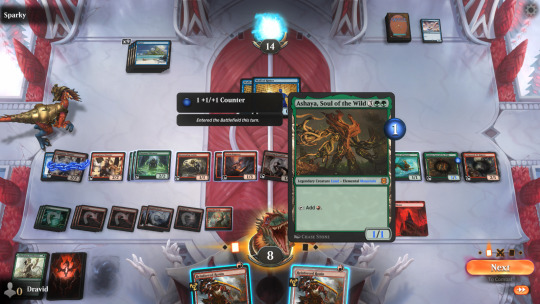
*it was not a quick trip
#original#about the disclaimer: what i mean by “i'm pretty sure i'm right” is that the alternative is that each object is evaluated separately#like. in order#and then how would you determine what order to evaluate the objects in?#if ashaya gets evaluated first then it turns itself into a forest but then loses its ability#so then when you evaluate the other creatures ashaya's ability won't turn them into lands#but if you evaluate the other creatures first then ashaya WILL turn them into lands because its ability hasn't been removed yet#and that is so much more fucked up#so yeah i'm pretty sure it evaluates the entire game state at once#this whole “separate game states” model is just that: a model#there aren't literally multiple game states in existence it's just a useful way of understanding how continuous effects are applied#and how an ability can exist and affect things even if it isn't present in the final game state#the important part is that you start from the unmodified characteristics of the board#also i had to craft blood moon in order to get those screenshots#i wrote up this entire thing and then thought “wait maybe i should actually make sure i'm right”#and i am! so yeah i'm probably right mostly kinda#the model works!
3 notes
·
View notes
Text
Thor in Thor 3 and 4 was a 'role model' for boys in the most superficial 'be strong' way. i would rather suggest a deeper reading featuring not minding getting hit on by the GM and Stormbreaker-riding subtext
#don't worry guys i know exactly what messages to osmosis from these movies#😎👍👍#like no sorry i don't think being mean constitutes good hero behaviour nor do i think Thor solved anything beyond plot convenience#being confident is great but don't be an arrogant jerk about it#Thor in Thor 3 and 4 isn't a role model and takes zero moments to self evaluate#he doesn't think about the consequences to his actions and this?? after his arc on self reflection??????????#yeah i don't think so
8 notes
·
View notes
Text
2 notes
·
View notes
Text
i cant stop thinking about the fact that the us and uk killed one million people in indonesia as part of the cold war effort and barely anybody knows about it much less cares. trying to tell somebody about it especially in the west will just garner laughter and celebration -- genocide is okay if they are (true or suspected) communists, no matter what. one million people
#history#politics#I had no idea good god#sea history Cold War particularly US involvement is barely taught#there needs to be more beyond the Vietnam War and even that is pitifully taught#we need to evaluate American SEA erasure#in history and in the model minority myth among other things
6K notes
·
View notes
Text
Course: Effective Financial Modelling in the Power Industry+201010232279
Want to enhance your financial decision-making in the power industry?
Struggling with financial data analysis and risk management?
Join the Effective Financial Modelling in the Power Industry course and gain essential skills!
االجودة الأوربية — European Quality
Build accurate financial models using Excel
Improve project performance with advanced data analysis
Assess risks and make smarter financial decisions
Don’t miss out — secure your spot now!
For inquiries & registration:
+2010 10232279
— — — — — — — — — — — — — — — — — — — —
#financialmodelling#powerindustry#energyfinance#FinanceTraining#RiskManagement#excelforfinance#projectfinance#InvestmentAnalysis#businessgrowth#financialplanning#oilandgas#petroleum #gasandoil#EnergySector#financeprofessionals
financial modelling, power industry, energy finance, financial analysis, risk management, Excel for finance, investment strategies, financial decision-making, project evaluation, corporate finance, energy sector, cost optimization, financial forecasting, capital investment, financial performance

#financialmodelling#powerindustry#energyfinance#FinanceTraining#RiskManagement#excelforfinance#projectfinance#InvestmentAnalysis#businessgrowth#financialplanning#oilandgas#petroleum#gasandoil#EnergySector#financeprofessionals#financial modelling#power industry#energy finance#financial analysis#risk management#Excel for finance#investment strategies#financial decision-making#project evaluation#corporate finance#energy sector#cost optimization#financial forecasting#capital investment#financial performance
0 notes
Text
Data-Driven Decisions: How Sabermetrics and AI are Shaping Baseball Strategy

Baseball, a sport steeped in tradition, is increasingly embracing the power of data analysis to gain a competitive edge. Sabermetrics, the empirical analysis of baseball statistics, has transformed the way teams evaluate players, make strategic decisions, and build winning rosters. The emergence of artificial intelligence (AI) is further enhancing these capabilities, providing even more sophisticated tools for analyzing data and predicting outcomes.
Optimizing In-Game Decisions
Sabermetrics provides valuable insights into various aspects of game strategy. For instance, research has identified the most important factors influencing stolen base success, including the number of pitches thrown during the at-bat, the speed of the pitch, the baserunner's sprint speed, and the game situation. This information can help coaches make more informed decisions about when to attempt a stolen base.
Building a Winning Team
Data analysis also sheds light on team performance and roster construction. Studies have shown that the depth of a team's relief pitching, rather than the performance of a single star reliever, is a crucial factor influencing a team's winning percentage. This suggests that general managers should prioritize building a strong bullpen with quality depth over acquiring a single high-performing relief pitcher.
Predicting Player Performance
Sabermetrics and AI are also valuable tools for evaluating and predicting player performance. Traditional statistics, such as batting average and ERA, are being supplemented with advanced metrics like exit velocity, launch angle, and spin rate. AI models can analyze these data points to predict player development, identify potential draft picks, and even forecast contract renewals.
Advanced Modeling Techniques
Sophisticated models are being developed to analyze and predict various aspects of the game. The zero-inflated bivariate binomial (ZIBVB) model effectively captures zero-inflation patterns in baseball data, allowing for simultaneous inference on two success probabilities and the zero-inflation parameter. This can help make more informed decisions about player selection and game strategy.
Challenging Traditional Beliefs
Data analysis is also challenging some traditional beliefs in baseball. For example, research has challenged the Time Through the Order Penalty (TTOP), the belief that batters perform significantly better against pitchers the more times they face them in a game. This suggests that managers should consider a pitcher's overall quality, rather than relying solely on TTOP when making decisions about pulling a pitcher.
AI and the Future of Baseball Analytics
AI is poised to play an even greater role in baseball analytics in the future. Machine learning models, such as Long Short-Term Memory (LSTM) neural networks, offer a promising approach for predicting home run performance. AI can also be used to develop more sophisticated scouting reports, optimize defensive positioning, and even predict the outcome of games.
Sabermetrics and AI are transforming the way baseball is played and analyzed. By harnessing the power of data, teams can make more informed decisions, optimize performance, and gain a competitive edge. As these technologies continue to evolve, we can expect even more innovative applications in the future, further revolutionizing the game of baseball.
PASS's Services:
Annual Guidebooks: PASS publishes annual guidebooks for various sports, summarizing the latest research and providing practical recommendations for training and performance optimization.
Custom Reports: PASS offers custom reports that delve deep into specific performance challenges, providing tailored solutions based on the latest scientific evidence.
Researcher Exchange: PASS facilitates workshops and Q&A sessions with leading sports scientists, allowing coaches and athletes to gain valuable insights and connect with experts in the field.
The potential of sports science to revolutionize training and performance is vast, but it remains largely untapped in many areas of athletics. By embracing research-backed principles and utilizing the services of organizations like PASS, coaches and athletes can unlock new levels of performance, reduce the risk of injuries, and achieve their full potential.
About PASS | Practical Application of Sport Science:
PASS helps top sports teams make better decisions using science. The teams ask questions like: “how to manage workload; how to improve decision-making; what is an optimal periodization program”. PASS takes a deep dive into all relevant research articles, figures out what's useful, and gives the teams specific advice they can immediately implement – only things that have been scientifically proven.
Explore the resources available at PASS (https://sportscience.pro/) and discover how sports science can transform your approach to training and performance.
#PASS#baseball#neurological factors#sabermetrics#baseball analytics#AI in baseball#game strategy#team performance#player evaluation#predictive modeling
0 notes
Text
i think there’s something to be said about how the gig economy makes things ostensibly more convenient but also worse. and not just like, doordash guys take too long to get to you so your food is cold. but because the business model is centered around a million people doing work without any familiarity with what theyre doing and decentralized from the businesses they’re working with, you get service that’s being reinvented from scratch every time it’s purchased.
it happens all the time that I’ll order an uber and when they pick me up, they’ll just stop in the middle of the street with their hazards on, making me dodge traffic to get to them and pissing off the cars around them. and then I’ll get in the car and chat with the driver and find out they’re actually from two counties over and they’ve never driven here before, so they don’t know where parking is or whether they’re heading to a wide open parking lot or a busy downtown. and then you start to realize that they’re not being a dick, they’re just given as little information as possible every time they pick up a ride so they have to just guess how and where to pick up a passenger. and since they’re paid by ride, they’re incentivized to pick you up as fast as possible. and all the people who cared about finding a safe place to pick you up quit the app or stopped doing that so all you’re left with is the pissed off cockroach motherfuckers.
and then you see that this happens with every fucking app. doordash sucks because you pay 8 million dollars for delivery and you still have to hike half a mile to find the guy because he got lost in your apartment complex. Instacart sucks because the guy picking your groceries couldn’t care less about getting ripe fruit and replaces your heavy cream with shaving cream. customer support for all this sucks because the guy helping you can’t do anything more than offer you $5 credit, beg for your forgiveness, and hope you get out of the queue fast enough for him to go to the bathroom. because all of them aren’t given enough time to do a good job or enough money to care.
and every time a gig worker makes the experience suck for you, it’s a rational decision. they’re evaluating the money they’re being paid and if it’s worth getting paid less to do a good job, and correctly deciding that it isn’t. so you can’t even get mad, because you’d do it too. and so the company manages to pass on its race to the bottom to its lowest-paid employees.
#there was a post i read once about how companies do this because it effectively insulates them from customers anger#because either you get mad at the person in front of you or you realize that it’s not their fault#and then what are you gonna do? complain to customer service about how customer service doesn’t get paid enough? get real#i wish i could remember exactly what it called the phenomenon
9K notes
·
View notes
Text
Jharkhand Launches School Report Card Initiative
State aims to boost academic standards in government schools with new evaluation system Jharkhand’s education department introduces a comprehensive school report card system to enhance academic quality in state-owned institutions. RANCHI – Jharkhand’s school education and literacy department has unveiled a new initiative to issue report cards for state-owned schools, aiming to improve academic…
#राज्य#educational quality monitoring#government school evaluation#JEPC school assessment#Jharkhand education reform#Jharkhand model schools#Jharkhand school certification system#Jharkhand school report card#Project Impact Jharkhand#school performance transparency#state#state-owned school improvement
0 notes
Text
Comprehensive Guide to Employee Competency Evaluation
Understanding the Capability Assessment Model
In modern organizational contexts, employee competency evaluation is a critical process that determines the skills, knowledge, and potential of individuals within a workforce. A well-structured capability assessment model goes beyond routine performance reviews, aiming to assess not only current skills but also future potential and developmental needs.
What is Employee Competency Evaluation?
Employee competency evaluation involves a systematic approach to assessing the capabilities and competencies of employees. It encompasses various methodologies such as skills assessments, behavioral interviews, and performance evaluations to gain a comprehensive understanding of an employee's strengths and areas for improvement.
Importance of Work Capability Assessment
Enhancing Workforce Capability
A robust work capability assessment is pivotal in identifying gaps in skills and knowledge within an organization. By evaluating workforce capabilities, organizations can strategically plan for training, recruitment, and development initiatives that align with business objectives.
Building Workforce Capability for Future Challenges
The process of building workforce capability involves not only identifying current skills but also preparing employees for future roles and responsibilities. This proactive approach ensures that organizations are agile and ready to adapt to changing industry demands.
Key Components of Employee Competency Evaluation
1. Assessing Core Competencies
Effective employee competency evaluation begins with defining and assessing core competencies relevant to each role within the organization. This includes technical skills, soft skills, and leadership qualities essential for job performance.
2. Identifying Developmental Needs
An integral part of capability assessment is identifying developmental needs based on current performance and career aspirations. This enables organizations to create personalized development plans that foster continuous improvement and career progression.
3. Aligning Assessments with Organizational Goals
Aligning work capability assessment outcomes with organizational goals ensures that talent management strategies are strategically aligned with business objectives. This alignment maximizes the impact of competency evaluations on overall organizational performance.
Conducting Effective Employee Competency Evaluations
Establishing Clear Evaluation Criteria
To ensure consistency and fairness, it's crucial to establish clear evaluation criteria that reflect the specific requirements of each role and the organization's strategic priorities. This clarity helps in making informed decisions about performance and development.
Involving Stakeholders in the Assessment Process
Engaging stakeholders, including managers and team leaders, in capability assessment processes enhances the credibility and relevance of evaluations. It also provides multiple perspectives on an employee's performance and potential contributions.
Providing Constructive Feedback and Development Plans
Effective workforce capability assessment includes providing constructive feedback to employees based on assessment outcomes. This feedback should be actionable and accompanied by development plans that outline steps for improvement and growth.
Benefits of Employee Competency Evaluation
1. Enhanced Performance Management
By understanding and evaluating employee competencies, organizations can implement targeted performance management strategies that optimize productivity and employee engagement.
2. Strategic Workforce Planning
Employee competency evaluation supports strategic workforce planning by identifying skill gaps and future talent needs. This foresight enables proactive recruitment and succession planning initiatives.
3. Personalized Career Development
Capability assessments pave the way for personalized career development plans that align individual aspirations with organizational goals. This personalized approach boosts employee morale and retention.
#employee competency evaluation#capability assessment model#work capability assessment#workforce capability assessment#building workforce capability
0 notes
Text
Regression & Classification with MNIST
A Comprehensive Guide to Machine Learning: Regression and Classification with the MNIST Dataset A Comprehensive Guide to Machine Learning: Regression and Classification with the MNIST Dataset Introduction to Supervised Learning: Regression and Classification In the realm of machine learning, supervised learning involves training a model on a labeled dataset, which means the dataset includes both…
#artificial intelligence#classification#deep learning#evaluate model#machine learning#mnist#regression
1 note
·
View note
Text
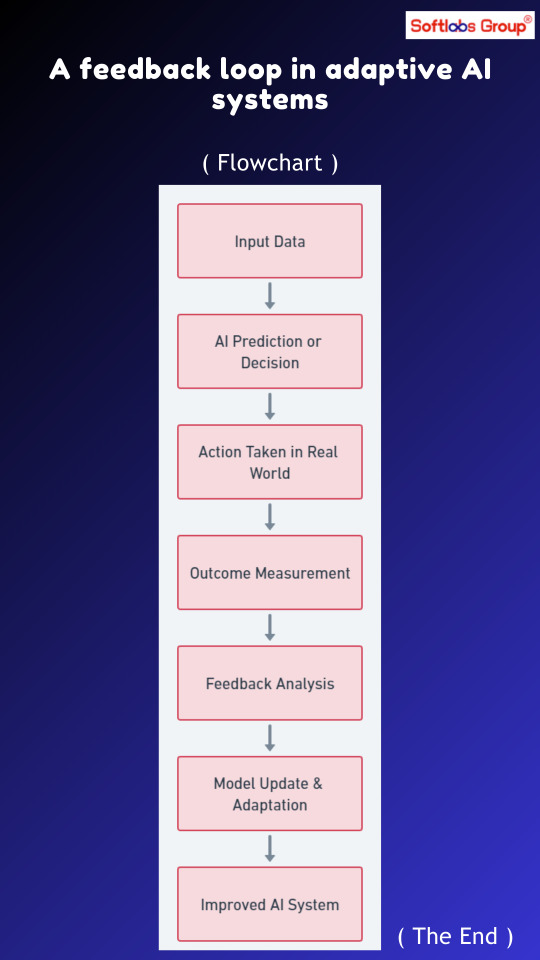
Explore the feedback loop in adaptive AI systems with our illustrative flowchart. Follow stages including data collection, model adjustment, performance evaluation, feedback analysis, and model update. Simplify the process of continuously improving AI systems based on user feedback and changing conditions. Perfect for AI developers, engineers, and researchers. Stay informed with Softlabs Group for more insights into adaptive AI technologies!
0 notes